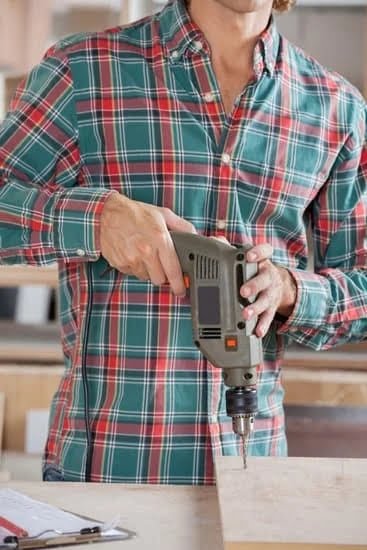Are you interested in learning how to calculate angles in woodworking? Accurately measuring and calculating angles is essential in creating precise and well-crafted woodworking projects. Whether you are working on simple DIY tasks or more complex carpentry projects, understanding the importance of angle calculation is crucial for achieving professional results.
In woodworking, angles play a vital role in determining the proper fit and alignment of pieces, as well as creating various joints and cuts. Understanding the different types of angles, such as acute, obtuse, and right angles, is fundamental to mastering the art of woodworking. Additionally, knowing how to measure and calculate these angles accurately is key to producing high-quality and structurally sound woodwork.
To successfully calculate angles in woodworking, it is essential to have the right tools and equipment at your disposal. From protractors to bevel gauges, having access to a comprehensive set of measuring instruments is necessary for achieving precision in angle calculation. Moreover, familiarizing yourself with the step-by-step techniques for measuring and calculating angles will equip you with the skills needed to excel in your woodworking endeavors.
Types of Angles in Woodworking
In woodworking, understanding and accurately calculating angles is crucial for successful project outcomes. Different types of angles play significant roles in determining the fit, joinery, and overall aesthetics of the finished piece. Therefore, it is essential for woodworkers to have a good grasp of acute, obtuse, and right angles and how they are utilized in woodworking projects.
Acute Angles
Acute angles in woodworking typically refer to angles that are less than 90 degrees. These angles are commonly found in various components of furniture such as chair legs, table supports, or intricate decorative elements. Understanding how to measure and cut acute angles accurately is vital in achieving structural integrity and visual appeal in woodworking projects.
Obtuse Angles
On the other hand, obtuse angles are greater than 90 degrees and can also be prevalent in woodworking designs. These angles may appear in certain joints or miter cuts where two pieces of wood need to be joined at an angle greater than 90 degrees. Woodworkers must be proficient in measuring and cutting obtuse angles precisely to ensure the strength and stability of their creations.
Right Angles
Right angles, measuring exactly 90 degrees, are fundamental in woodworking as they form the basis for many structures and joints. Whether it’s constructing a sturdy frame or ensuring perpendicularity between components, right angles are foundational to the craft. Knowing how to calculate right angles with precision is essential for maintaining accuracy throughout a project.
Understanding these different types of angles is essential for any woodworker striving for high-quality craftsmanship. By learning how to calculate angles in woodworking accurately, artisans can elevate their skill set and create impeccable pieces that stand the test of time.
Tools and Equipment Needed
Calculating angles in woodworking requires the use of specific tools and equipment to ensure accuracy and precision in your projects. It’s essential to have the right instruments at your disposal to measure and calculate angles effectively. Here is a comprehensive list of tools necessary for accurately measuring and calculating angles in woodworking:
1. Protractor: A protractor is a semi-circular tool used to measure and draw angles. It is an essential tool for determining the angle of a corner or marking precise angle measurements on a piece of wood.
2. Bevel Gauge: A bevel gauge, also known as an angle finder, is used to replicate and transfer angles onto workpieces accurately. It features an adjustable metal blade that can be set to any angle, making it a valuable tool for measuring and transferring angles during woodworking projects.
3. Combination Square: This versatile tool combines a ruler with a 90-degree handle. It can be adjusted to a specific angle, allowing woodworkers to accurately measure and mark cuts at both 90-degree and 45-degree angles.
4. Sliding Bevel: Also known as a T-bevel, this tool is used for transferring angles from one piece of wood to another or from one part of a project to another. It can also be locked at any angle, making it useful for setting up machinery or marking out complex joints.
By having these tools on hand, woodworkers can ensure that they are able to measure and calculate angles accurately, leading to better quality woodworking projects overall.
| Tool | Use |
|---|---|
| Protractor | Measuring and drawing angles |
| Bevel Gauge | Replicating and transferring accurate angles |
| Combination Square | Measuring and marking cuts at different angles |
| Sliding Bevel (T-Bevel) | Transferring angles between workpieces |
Measuring Angles
In woodworking, the ability to accurately measure and calculate angles is crucial for creating precise cuts and ensuring that pieces fit together seamlessly. Whether you are working on a simple DIY project or crafting intricate furniture, understanding how to measure angles using tools like a protractor or bevel gauge is essential.
To start, it’s important to familiarize yourself with the different types of angles commonly used in woodworking. Acute angles are less than 90 degrees, obtuse angles are greater than 90 degrees, and right angles are exactly 90 degrees. Knowing how to identify and measure these angles will help you determine the correct cuts needed for your woodworking project.
When it comes to measuring angles in woodworking, there are two primary tools that you’ll need: a protractor and a bevel gauge. A protractor is typically used for measuring and drawing angles, while a bevel gauge is designed specifically for transferring an angle from one piece to another. Both tools are essential for accurately determining the angle at which you need to make your cuts.
| Measurement Tool | Primary Use |
|---|---|
| Protractor | Measuring and drawing angles |
| Bevel Gauge | Transferring an angle from one piece to another |
Calculating Angles
In woodworking, accurate calculation of angles is crucial to ensure that pieces fit together perfectly and create a sturdy final product. Whether you’re working on miter cuts, compound angles, or other complex designs, knowing how to calculate angles is essential for achieving professional results.
Measuring and calculating angles can be done using a variety of tools and techniques. The following are some key methods for accurately calculating angles in woodworking:
- Using a Protractor: A protractor is a simple but effective tool for measuring and calculating angles. It consists of a semi-circular disk marked with degrees from 0 to 180. To use a protractor, place the center hole over the corner point of the angle and align the base line along one side of the angle. Then read the degree measurement where the other side of the angle intersects with the protractor.
- Using a Bevel Gauge: A bevel gauge is another useful tool for measuring and transferring angles. This tool allows woodworkers to set an angle by adjusting the bevel arm until it matches the desired angle, then lock it in place to transfer the measurement to their workpiece.
- Calculating Compound Angles: When working with compound angles, it’s important to understand how to calculate both horizontal and vertical components separately. This involves breaking down complex angles into their individual components using trigonometric functions such as sine, cosine, and tangent.
By mastering these techniques for calculating angles in woodworking, you can ensure that your projects come together seamlessly and meet your exact specifications. With practice and attention to detail, you’ll be able to tackle even the most intricate designs with confidence and precision.
Common Mistakes and How to Avoid Them
When it comes to woodworking, accurate angle calculation and measurement are crucial for achieving precise and high-quality results. However, there are common mistakes that can be made when calculating angles in woodworking that can lead to errors and imperfections in your project. Here are some tips for avoiding these mistakes and ensuring that your angle calculations are on point:
1. Using the wrong tools: One of the most common mistakes in angle measurement is using the wrong tools or using them incorrectly. To avoid this, make sure to use a reliable protractor or bevel gauge specifically designed for woodworking. Using a low-quality or unsuitable tool can lead to inaccurate measurements.
2. Incorrect placement of the measuring tool: Another common mistake is placing the measuring tool incorrectly on the wood surface. When measuring an angle, ensure that the base of the protractor or bevel gauge is aligned with the edge of the wood to get an accurate reading.
3. Inaccurate marking of the wood: After measuring and calculating the angle, it’s essential to mark the wood accurately before making any cuts. Using a sharp pencil or marking knife, carefully transfer the measurement onto the wood to ensure precision in cutting.
These tips will help you avoid common mistakes when calculating angles in woodworking and improve the accuracy of your projects. By using the right tools, being mindful of placement, and properly marking your wood, you can achieve precise angles for all your woodworking needs.
Practical Application
Enhancing Structural Integrity
One of the key practical applications of accurate angle calculation in woodworking is the enhancement of structural integrity in projects. Whether it’s constructing furniture, building cabinets, or framing a deck, ensuring that angles are precisely measured and cut can make a significant difference in the stability and longevity of the final product.
For instance, in cabinetry, accurately calculated angles prevent gaps and misalignments, resulting in a professional finish and improved functionality. In the construction of tables or chairs, precise angle measurements guarantee that pieces fit together seamlessly, improving overall stability.
Creating Aesthetically Pleasing Designs
Accurate angle calculation also plays a crucial role in creating aesthetically pleasing woodworking designs. When working on intricate joinery or decorative elements, such as picture frames or window casings, precise angles contribute to seamless joints and clean lines. This attention to detail elevates the overall visual appeal of woodworking projects by eliminating unsightly gaps or uneven seams. Additionally, accurate angle measurement ensures that components fit together seamlessly, enhancing the overall harmony and balance of the finished piece.
Minimizing Material Wastage
Another real-life benefit of mastering how to calculate angles in woodworking is minimizing material wastage. By accurately measuring and calculating angles for cuts, woodworkers can optimize material usage and reduce unnecessary waste. This not only saves money but also minimizes environmental impact by utilizing resources efficiently. Whether working with expensive hardwoods or more affordable materials, precision in angle calculation leads to fewer mistakes and ultimately reduces the amount of discarded scrap pieces.
By understanding these practical applications and harnessing techniques for measuring and calculating angles accurately, woodworkers can elevate their craft by producing high-quality pieces that are structurally sound, visually appealing, and eco-friendly.
Conclusion
In conclusion, the ability to accurately calculate angles is a crucial skill for any woodworker. Understanding the various types of angles and how to measure and calculate them is essential for achieving precision and consistency in woodworking projects. Whether it’s creating miter cuts for picture frames or constructing complex compound angles for furniture pieces, the techniques outlined in this article will undoubtedly prove invaluable.
By identifying the tools needed and providing step-by-step instructions on measuring and calculating angles, this article has equipped readers with the knowledge to execute their woodworking projects with confidence. Avoiding common mistakes in angle calculation is equally important, as it can greatly impact the overall quality of a finished piece. By being aware of potential errors and how to prevent them, woodworkers can strive for excellence in their craft.
Ultimately, the practical application of accurate angle calculation in woodworking cannot be overstated. From ensuring tight joints to creating intricate designs, every aspect of a project hinges on precise angle measurement and calculation.
Therefore, by applying the techniques learned from this article, woodworkers can elevate the quality of their work and take their skills to new heights. So, whether you’re a seasoned professional or just starting out in woodworking, mastering how to calculate angles is an essential skill that will undoubtedly set you on the path to success.
Frequently Asked Questions
How Do You Measure Angles for Framing?
Angles for framing can be measured using a tool called a bevel gauge, which allows carpenters to accurately determine the angle of a corner or joint. By aligning the bevel gauge with the two surfaces that form the angle, carpenters can then transfer that measurement onto their workpiece for precise cutting and fitting.
How Do You Calculate Angles?
Angles can be calculated using trigonometric functions such as sine, cosine, and tangent. This is particularly useful when dealing with non-standard angles that may not be easily measured with traditional tools. By using trigonometry, carpenters can calculate angles based on the lengths of the sides of a triangle formed by the angle in question.
What Tools Can Carpenters Use to Calculate Angles?
Carpenters have several tools at their disposal for calculating angles, including the aforementioned bevel gauge, protractors, combination squares, and digital angle finders. These tools allow carpenters to measure, transfer, and verify angles with accuracy, ensuring that their cuts and joints are precisely aligned according to project specifications.

Hi everyone! I’m a woodworker and blogger, and this is my woodworking blog. In my blog, I share tips and tricks for woodworkers of all skill levels, as well as project ideas that you can try yourself.





